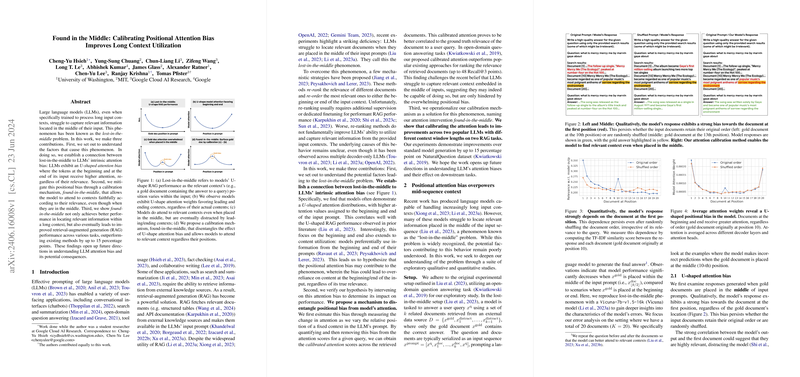Calibrating Positional Attention Bias Enhances Long Context Utilization in LLMs
In the paper titled "Found in the Middle: Calibrating Positional Attention Bias Improves Long Context Utilization," Hsieh et al. address a critical challenge in the deployment of LLMs: the "lost-in-the-middle" phenomenon. This issue pertains to LLMs' struggle in capturing relevant information located in the middle of lengthy input contexts. The authors investigate this phenomenon, which undermines the potential of retrieval-augmented generation (RAG) techniques and document critical findings and a novel mitigation strategy.
Key Findings and Contributions
- Understanding Intrinsic Positional Attention Bias: The paper identifies that LLMs exhibit a U-shaped attention distribution, inherently prioritizing tokens at the beginning and end of their input sequences over those in the middle. This discovery connects the lost-in-the-middle problem with an intrinsic positional attention bias, wherein the models, irrespective of the actual relevance, allocate higher attention to boundary tokens.
- Calibration Mechanism - Found-in-the-Middle: The authors propose "found-in-the-middle," a calibration mechanism aimed at mitigating this positional attention bias. This method adjusts the attention weights to better reflect the actual relevance of the context, irrespective of position. Essentially, this aims to disentangle the positional bias from the attention mechanism, allowing the model to attend to relevant contexts appropriately based on their substantive importance rather than their placement.
- Empirical Validation and Performance Improvement: The application of the found-in-the-middle mechanism demonstrates substantial improvements in model performance on long context tasks. The calibration method achieves up to 15 percentage points improvement over existing approaches across various tasks and datasets, particularly in RAG performances. These results are robust across different LLMs, such as Vicuna-7b-v1.5-16k and Tulu-2-7b, indicating the broad applicability and efficacy of the proposed solution.
Detailed Experimentation and Insights
U-shaped Attention Bias
Through qualitative and quantitative studies, the researchers demonstrate the substantial influence of positional bias. Even when context documents are shuffled, the model's responses exhibit strong dependencies on the documents placed at the initial and end positions. This was validated by visualizing self-attention weights, showing a clear U-shaped pattern that persists irrespective of document content.
Modeling and Isolating Bias
To understand and correct this bias, the authors model the observable attention weights as a function of both document relevance and positional bias. They hypothesize a linear relationship between the modeled and actual attention values, which is validated with high rank correlations of over 0.75. This simple yet effective model allows the disentangling of positional attention bias, leading to what they term as calibrated attention.
Practical Implications
The calibrated attention method was tested on datasets such as NaturalQuestions and SynthWiki, demonstrating superior performance in ranking the relevance of retrieved contexts. This indicates that the method effectively enhances LLM capabilities in handling long contexts, a significant step forward in practical LLM applications.
Moreover, the paper shows that the attention calibration can complement existing reordering mechanisms. Methods like LongLLMLingua- and attention sorting benefit from an additional layer of calibration, leading to further performance enhancements.
Theoretical and Practical Implications
The findings of this paper have profound implications for both theoretical understanding and practical application of LLMs. Theoretically, it provides a framework for understanding and mitigating intrinsic biases in LLM attention mechanisms. Practically, it offers a robust solution for improving the retrieval and application of relevant long-context information in user-facing applications, such as conversational agents and complex query answering systems.
Future Directions
The research opens several avenues for further exploration:
- Further Refinement of Attention Models:
While the proposed linear model is effective, exploring more intricate models might yield even better calibration results.
- Exploration of Bias Origins:
Understanding the root causes of positional attention bias could lead to more fundamental improvements in model architecture and training processes.
- Scalability and Efficiency:
The computational overhead introduced by attention calibration suggests a need for optimized implementations that maintain the benefits without significantly increasing the computational costs.
Conclusion
Hsieh et al. provide a substantial contribution to the understanding and amelioration of the lost-in-the-middle issue in LLMs. Through a well-validated calibration mechanism, they demonstrate how addressing positional biases can significantly improve long-context utilization in RAG tasks. This has broad implications for the development of LLMs, enhancing their efficiency and efficacy in practical applications requiring the processing of extensive input contexts.
